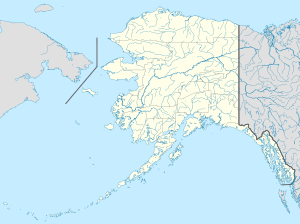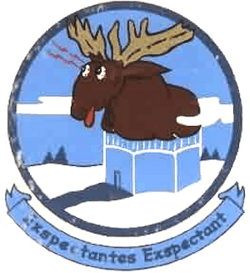Cape Romanzof Air Force Station facts for kids
Quick facts for kids Cape Romanzof Air Force StationCape Romanzof Long Range Radar Site |
|
|---|---|
| Part of Eleventh Air Force (PACAF) | |
|
Location of Cape Romanzof AFS, Alaska
|
|
| Coordinates | 61°47′23″N 165°57′43″W / 61.78972°N 165.96194°W |
| Type | Air Force Station |
| Site information | |
| Controlled by | |
| Site history | |
| Built | 1951 |
| In use | 1953-Present |
| Garrison information | |
| Garrison | 795th Aircraft Control and Warning Squadron (1953–1983) |
Cape Romanzof Air Force Station was once an important radar station. It was run by the United States Air Force. This station helped watch for planes in the sky.
It is located in a remote part of Alaska. The station was closed on November 1, 1983. Today, it is still used as a Long Range Radar (LRR) site. It helps protect the skies over Alaska.
Contents
History of Cape Romanzof Air Force Station
Cape Romanzof AFS was built during the Cold War. Its main job was to give early warnings. It would alert the United States Air Force if the Soviet Union attacked Alaska.
Building the Radar Station
Construction started in 1950. The Army Transportation Corps helped get supplies there. It was very hard to build the station. Supplies came by barge or Navy ships. But this was only possible when the sea was not frozen.
Ships had to unload 15 miles from the site. There were no roads at first. Everything had to be hauled along the beach. Then it was moved five more miles inland.
Life at the Station
The station opened in April 1953. The 795th Aircraft Control and Warning Squadron ran it. The main camp was in a valley. It was 1,500 feet up in the Azkinuk Mountains. There was also a landing strip near the sea.
Life at the station was tough. Winters were very cold. Buildings were connected by tunnels. This meant people did not have to go outside much. Tours of duty were only one year long. This was because of the hard conditions.
Radar Operations and Challenges
The radars were on a mountain peak. This peak was 2,300 feet high. A tramway connected the camp to the radars. But the tramway cables often broke. High winds and ice caused many problems. Fog and extreme cold made repairs dangerous. Ice could build up 16 inches thick on the cables.
Cape Romanzof sent information 24 hours a day. This data went to the air defense center at King Salmon AFS. The data helped figure out if planes were friendly or not. The station used different types of radars over time. These included the AN/FPS-3 and AN/FPS-117.
Communication Systems
At first, radio systems were used for communication. But they were not always reliable. So, the Air Force built the White Alice Communications System. This was a network of radio sites. The Cape Romanzof site for White Alice opened in 1957.
This system was later replaced in 1979. A satellite system took its place. This was part of a plan to use newer technology.
Upgrades and Closure
Over the years, the station's equipment was updated. This made the radar information better. In 1983, Cape Romanzof got a new AN/FPS-117 radar. This radar could send data by satellite. It went to the control center at Elmendorf AFB.
Because of the new radar, the 795th AC&W Squadron was closed. This happened on November 1, 1983. The station became a Long Range Radar (LRR) Site. In 1990, its control moved to the Eleventh Air Force.
Cleaning Up the Site
In 1998, "Operation Clean Sweep" began. This project cleaned up old Cold War stations in Alaska. The goal was to restore the land. The 611th Civil Engineering Squadron did the cleanup. Work was finished by 2005. Today, not much is left of the old station.
Current Status of the Site
Today, the Pacific Air Forces 611th Air Support Group controls the site. It is usually not staffed by many people. Civilian contractors visit the site. They use the Cape Romanzof LRRS Airport to get there. They provide maintenance for the radar system.
Air Force Units and Assignments
Units that Served Here
- Constituted as the 795th Aircraft Control and Warning Squadron on November 3, 1952
- Activated on December 8, 1952
- Inactivated on November 1, 1983
Assignments of the Squadron
- 531st Aircraft Control and Warning Group, December 8, 1952
- 10th Air Division, April 13, 1953
- 5039th Aircraft Control and Warning Group (later 5040th Aircraft Control and Warning Group), June 1, 1957
- 10th Air Division, November 1, 1959
- 5070th Air Defense Wing, August 1, 1960
- Alaskan Air Command, October 1, 1961
- 531st Aircraft Control and Warning Group (later 11th Tactical Control Group, 11th Tactical Control Wing), December 2, 1978 - November 1, 1983






